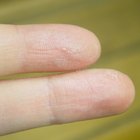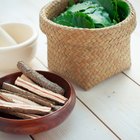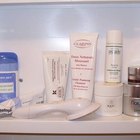
PhotoObjects.net/PhotoObjects.net/Getty Images
Grapefruit is more than a tasty food. Oil extracted from its rind, pulp and seeds is used in eco-friendly surface cleaners and as a safe and natural vegetable and fruit wash. Grapefruit seed extract, meanwhile, offers benefits to the skin. Grapefruit seed extract is available as a powder, but its most common form is liquid.
Properties
Grapefruit is rich in natural ingredients that nourish and protect the skin, including vitamins A, C and E and antioxidants. It also boasts essential phytonutrients -- such as lycopene, beta-carotene and bioflavonoids -- that promote cellular health. Some of these benefits can be gained by topical application. An extract provides the most concentrated form of a substance.
Fungicidal Skin Benefits
For people who love the skincare benefits of tea tree oil but prefer a citrus aroma, grapefruit seed extract is a good alternative. The effectiveness of grapefruit seed extract as a topical fungicide has been demonstrated in products to treat athlete’s foot and fungal infections of fingernails and toenails. The extract also is known to kill many strains of fungi, bacteria, viruses and parasites on the skin. Grapefruit seed extract usually is safe enough to apply full-strength to affected areas of skin on the body but may be too strong full-strength for sensitive facial skin.
Antibacterial Skin Benefits
Grapefruit seed extract also has disinfectant, antiviral and antiseptic properties. Because it promotes skin health and healing, it is sometimes used in body washes, lotions and creams, and as a healing additive to foot soaks. It also is an ingredient in some shampoos and conditioners for scalp and hair health, as well as facial skincare products such as masks, cleansers and toners.
Cautions
Often, commercial grapefruit seed extracts contain benzethonium chloride – a manmade antimicrobial ingredient also used in some cosmetics – and chemical preservatives such as triclosan and methylparaben. These may affect the product's effectiveness or cause an allergic reaction. Check with your physician before using products that contain these ingredients. Also, avoid direct contact between the extract -- and products containing it -- and your eyes. To test for possible allergic reaction before using, apply on a small area of the skin, such as the inside of the elbow. Wait a day before using as intended.
Related Articles

The Use of Neem Juice in Skin Care as ...

Benefits of Shea Butter and Coconut Oil ...

How to Get Nail Glue Off of Your Skin

Benefits of Green Tea Soap

Merle Norman Ingredients

What Is Aloe Good For?

Can Borage Oil Help Acne?

Chamomile Essential Oil Benefits

What Is Glycerine Used For?

How to Remove the Smell of Cologne From ...

Uses for Castor Oil on the Skin

Burt's Bees Ingredient List

Neutrogena Ingredients

Peeling the Spiny Chayote Squash

Neem Bark Benefits

Dangers of Spray on Tan

Does Microdermabrasion Work to Remove ...

Fresh Homemade Orange Juice Will Stay ...

What Is Hand Salve?

How to Substitute Dried for Fresh Dill ...
References
Writer Bio
LaMont Jones was an award-winning fashion and beauty editor for a decade at the "Pittsburgh Post-Gazette." A five-time nominator and judge of the CFDA Awards, he covers New York Fashion Week regularly. Jones is a 2011 inductee into the Pittsburgh Fashion Hall of Fame and coaches fashion models.
Photo Credits
PhotoObjects.net/PhotoObjects.net/Getty Images